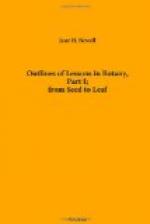How many leaves are there in the buds?
How are they arranged?
Where does the flower-cluster come in the bud?
Do all the buds contain flower-clusters?
What is the use of the wool and the gum?
Where do the buds come on the stem?
Which are the strongest?
How are the leaves arranged on the stem?
Do the pairs stand directly over each other?
What are the dots on the leaf-scars?
How old is your branch?
How old is each twig?
Which years were the best for growth?
Where were the former flower-clusters?
What happens when a branch is stopped in its growth by flowering?
What effect does this have on the appearance of the tree?
In some parts of the country the Horsechestnut is not so commonly planted as in New England. In the southern states the Magnolia may be used in its stead, but it is not nearly so simple an example of the main points to be observed.[1]
[Footnote 1: Reader in Botany. VII. Trees in Winter.]
MAGNOLIA UMBRELLA.
The bud may be examined by removing the scales with a knife, as in Horsechestnut, and also by cutting sections. The outer scales enfold the whole bud, and each succeeding pair cover all within. They are joined, and it is frequently difficult to tell where the suture is, though it can generally be traced at the apex of the bud. On the back is a thick stalk, which is the base of the leaf-stalk. Remove the scales by cutting carefully through a single pair, opposite the leaf-stalk, and peeling them off. The scales are modified stipules, instead of leaf-stalks, as in Horsechestnut. The outer pair are brown and thick, the inner green, and becoming more delicate and crumpled as we proceed toward the centre of the bud. The leaves begin with the second or third pair of scales. The first one or two are imperfect, being small, brown, and dry. The leaves grow larger towards the centre of the bud. They are covered with short, silky hairs, and are folded lengthwise, with the inner surface within (conduplicate). In the specimens I have examined I do not see much difference in size between the buds with flowers and those without. In every bud examined which contained a flower, there was an axillary bud in the axil of the last, or next to the last, leaf. This bud is to continue the interrupted branch in the same way as in Horsechestnut.
There are from six to ten good leaves, in the buds that I have seen. Those without flowers contain more leaves, as in Horsechestnut. In the centre of these buds the leaves are small and undeveloped. The flower is very easy to examine, the floral envelopes, stamens and pistils, being plainly discernible. The bud may also be studied in cross-section. This shows the whole arrangement. The plan is not so simple as in Horsechestnut, where the leaves are opposite. The subject of leaf-arrangement should be passed over until phyllotaxy is taken up.




